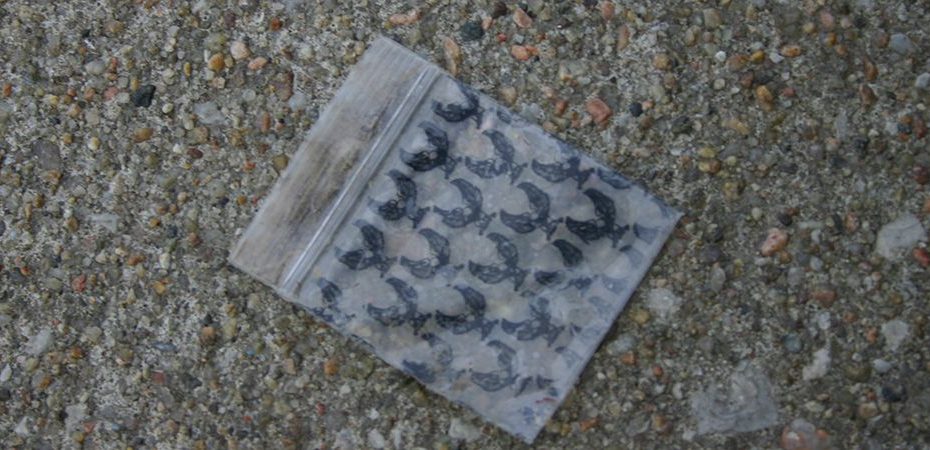It is hard to look away from the tragedy the opioid crisis has wreaked on human lives in Canada. An estimated 21 people will die every day due to opioid overdoses according to the federal government. The rage and hurt that the opioid epidemic has caused can be wholly consuming, but this goes beyond human beings: animals are at risk too.
Nicholas Boyce is the Policy Director of the Canadian Drug Policy Coalition and has been a harm reduction advocate since the 1990s. “I got involved with a group in Toronto called TRIP! which was the Toronto Raver Info Project,” says Boyce. “We would take people in the nightclub and rave scene and do education with them and training. And it wasn’t about telling people not to use drugs, but it was about if you’re going to do them, you just had to do them more safely.”
Recreational drugs paraphernalia littered © Richie Graham CC BY 2.0
Throughout his 30 years in the scene Boyce has seen the toll that miseducation about drug use has taken. And as the opioid crisis began, he saw the systemic neglect and inaction courtesy of government, pharmaceutical corporations and illicit producers become even more of a cultural focal point.
The effects of human-made chemicals in lakes and streams have been reported for a number of years. From trout becoming addicted to methamphetamine to minnows undergoing forced feminization, scientists and the media are aware of this broader phenomenon. Still, in spite of its status as a perpetual headline maker, little is known about the opioid crisis’ effect on animals.
“I did a study a few years ago where we caged goldfish at Hamilton Harbour, downstream of the wastewater treatment plant,” recalls researcher at the Aquatic Omics Lab in Oshawa, Denina Simmons. “After only three weeks the goldfish accumulated a high level of serotonin reuptake inhibitors, which are antidepressants.”
Simmons states that the concentrations of opioids that are present in the water are very low. The tap water humans drink is not at risk. That is not necessarily a victory though.
Syringe flotsam along a shoreline © Conor Lawless CC BY 2.0
“When humans are seeking drugs, they are going out of their way to put high quantities in at once to get a buzz,” explains Simmons. “I would say that animals that come in contact with this would have a much lower dose but very chronic, constant…it’s like breathing it in for them.”
“In medaka [fish], for example, [scientists] saw codeine was causing certain hormones to decrease,” says Simmons’ fellow researcher, Tyler Dow. “In crayfish they saw altered mobility and behavior as well. With zebrafish larvae it was even affecting their survivability.”
Dow makes sure to specify that these cases were all found in lab-based studies. The fish involved had always been monitored by humans and were given measured doses of opioids. Information about wild animals has not been published yet – it hasn’t even started as far as Dow and Simmons are aware.
“This is a few years away from getting any answers on our end and then in the greater broader scientific community,” Simmons tells me. “I don’t even think a lot of people are asking these questions… the fact that you asked this question is so incredible.”
A raft of floating trash near mallard ducks © Benny Lin CC BY-NC 2.0
Research would likely start with insects like fly larvae before working its way up the food chain to salamanders, frogs and fish. Without hard data though Simmons and Dow are unable to say just how opioids could affect aquatic species. And that is not their or any other researchers’ fault.
“It’s difficult to measure opioids on living things, and we’re working on methods to do that,” says Simmons. “It’s difficult to work with controlled substances. They’re illegal. Not a lot of labs have the permits and the capability to do [that].”
To obtain opioids for study, researchers have to lodge special requests with Health Canada, the Canadian Food Inspection Agency or even the Royal Canadian Mounted Police. Making opioids easier to study would require sweeping reforms on how illicit substances are handled. This type of policy change is continually front of mind for Boyce.
“If we actually regulated the drugs, we could put controls on how we produce them and think about the environment while also minimizing the harms to people,” says Boyce.
Plastic waste including pharmaceutical containers, Lake Ontario © Duncan Rawlinson CC BY-NC 2.0
When asked in a follow-up email just what an overhaul of drug regulations would look like, Boyce dubs it complicated, involving ground-shaking change on all levels of government.
In the meantime, education efforts among harm reduction workers could be a way to help control the flow of opioids into wastewater. “If we can link environmental and biodiversity protection [to] healthier societies and keeping people safer, I think it [would be] an important thing to bring these two movements together in some way,” says Boyce.
To minimize environmental impacts, Simmons argues more focus should be placed on large drug companies responsible for the opioid epidemic in the first place. “If you make it, you should know how to break it,” says Simmons, summing up her argument in couplet form. “If you’re manufacturing chemicals, you should also invest in the decontamination.”
Resources
The post There’s Something in the Water: Animals Face the Opioid Crisis appeared first on Ontario Nature.
